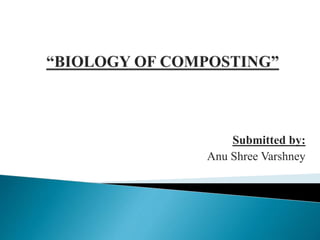
Biology of composting
- 1. Submitted by: Anu Shree Varshney
- 2. Composting is the biological decomposition or breakdown of organic material by bacteria and other organisms. Bacteria are the primary decomposing organism, but there are many others, including fungi, actinomycetes, worms and beetles. These organisms bring about decomposition by feeding on organic material. The result is compost or humus, a dark, nutrient-rich soil conditioner. There can be physical decompostion by the physical decomposers or there can be chemical decomposition by chemical decomposers.
- 3. CHEMICAL DECOMPOSERS (Microscopic organisms such as bacteria, fungi, and actinomycetes decompose organic material through a process of chemical decomposition)
- 4. 1. B ACTERIA: Bacteria are responsible for most of the decomposition and heat generation in compost. There are many different kinds of bacteria at work in the compost pile. Each type needs specific conditions and the right kind of organic material. (i) Psychrophilic bacteria : Psychrophiles are a type of extremophile. Bacteria that decompose organic material at temperatures below freezing. They work best at around 55°, they continue to work down to 0°F. As they work, they give off small amounts of heat. If conditions are good like plenty of oxygen, moisture, and nitrogen this heat will be enough to set the stage for the next group of bacteria, the “mesophylic,” or middle range temperature bacteria. Psychrophilic bacteria
- 5. (ii) Mesophilic bacteria : Their working temperature range is generally between 70°Fto 100°F. Mesophilic bacteria include hydrogen-oxidizing, sulfur- oxidizing, nitrifying, and nitrogen-fixing bacteria. Mesophilic microorganisms break down sugars, fats, starches and proteins releasing heat. Resistant to long carbon chain containing compound. When the pile temperature rises above 100º F, the mesophilic bacteria begin to die off or move to the outer part of the heap. They are replaced by heat-loving thermophilic bacteria. iii) Thermophilic bacteria: Thermophilic bacteria thrive at temperatures ranging from 113°F to 160°F. Thermophilic bacteria continue the decomposition process, raising the pile temperature 130°F to 160°F. As the thermophilic bacteria decline and the temperature of the pile gradually cools off, the mesophilic bacteria again become dominant. Mesophilic bacteria Thermophilic bacteria
- 6. 2. Actinomycetes: Organisms that resemble fungi but actually are filamentous bacteria. After bacteria, actinomycetes are the second most abundant micro-organism in your compost pile. Their enzymes enable them to chemically break down tough debris such as woody stems, bark, or newspaper. They give compost its pleasant earthy smell. They are especially important in the formation of humus - organic matter that has reached the final state of decomposition. As well, actinomycetes liberate carbon and nitrogen, making these important nutrients available to plants. Actinomycetes in composting
- 7. 3.Fungi: Fungi are smaller in number than bacteria or actinomycetes, but larger in body mass. Like actinomycetes, fungi are present during the final stages of composting, Fungal species are numerous during both mesophilic and thermophilic phases of composting. They prefer moderate temperatures 70- 75°F , although a few forms can live as high as 120°F. During higher temperature they live on outer layer of compost They can attack organic residues that are too dry, acidic, or low in nitrogen for bacterial decomposition. Fungi are also the only organisms that can break down lignin, the gluey substance found in woody materials. They work at a pH of 5.5-7.0, slightly more acid than the bacteria. Actively growing Fungal Mycelium in Compost
- 8. PHYSICAL DECOMPOSERS (Physical Decomposers are macro level organism.They are more active in the later, mature stages of the composting process, when temperatures are dropping but decomposition is not yet complete. Macro-decomposers ingest food physically, by grinding, chewing, sucking, digesting, and churning.It include centipedes, worms, beetles, and springtails etc ).
- 9. 1.Worms: If bacteria are the champion microscopic decomposers, then the heavyweight champion is doubtlessly the earthworm. As soil or organic matter is passed through an earthworm’s digestive system, it is broken up and neutralized by secretions of calcium carbonate from calciferous glands near the worm’s gizzard. Once in the gizzard, material is finely ground prior to digestion. Digestive intestinal juices rich in hormones, enzymes, and other fermenting substances continue the breakdown process. The matter passes out of the worm’s body in the form of casts, which are the richest and finest quality of all humus material. 2. Centipedes They are third-level consumers, feeding on soil invertebrates of their size or larger. This means they are unwelcome in a worm bin as they may attack and kill the worms. Earth Worms in Composting
- 10. 3. Ants: Ants prey are the first level consumers, and may benefit the composting process by bringing fungi and other organisms into their nests. Ants feed on a variety of material, including aphid honeydew, fungi, seeds, sweets, scraps, other insects, and sometimes other ants. Ants can make compost richer in phosphorus and potassium by moving minerals around as they work. 4. Millipedes: Millipedes have wormlike segmented bodies, with each segment having two pairs of walking legs (except the front few segments). Millipedes feed on moist decaying plant matter, helping break down the contents of your compost pile. Millipedes in composting
- 11. 5.Fflies: Flies are two-wing insects that feed on almost any kind of organic material. Although flies are not often a problem associated with compost piles, you can control their numbers by keeping a layer of dry leaves or grass clippings on top of the pile. Also, bury food scraps at least eight to twelve inches deep into the pile. 6.Snails and slugs : Snails have a spiral shell with a distinct head and retractable foot. Slugs do not have a shell and are somewhat bullet shaped with antennae on their front section. They feed primarily on living plant material, but they will also attack plant debris. Look for them in finished compost before using it, as they could do damage to your garden if they move in.
